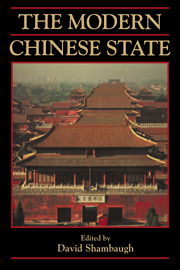Book contents
- Frontmatter
- Contents
- List of Contributors
- List of Illustrations
- List of Abbreviations
- Preface
- Introduction: The Evolving and Eclectic Modern Chinese State
- 1 The Late Imperial Chinese State
- 2 The Chinese State during the Republican Era
- 3 The Evolution of the State in the Republic of China on Taiwan
- 4 The Chinese State during the Maoist Era
- 5 The Chinese State in the Post-Mao Era
- 6 The Chinese Communist Economic State in Comparative Perspective
- 7 The Future of the Chinese State
- Index
7 - The Future of the Chinese State
Published online by Cambridge University Press: 15 October 2009
- Frontmatter
- Contents
- List of Contributors
- List of Illustrations
- List of Abbreviations
- Preface
- Introduction: The Evolving and Eclectic Modern Chinese State
- 1 The Late Imperial Chinese State
- 2 The Chinese State during the Republican Era
- 3 The Evolution of the State in the Republic of China on Taiwan
- 4 The Chinese State during the Maoist Era
- 5 The Chinese State in the Post-Mao Era
- 6 The Chinese Communist Economic State in Comparative Perspective
- 7 The Future of the Chinese State
- Index
Summary
Thinking about the future is an exercise in humility. Thinking about China's future, if its modern history is any guide, is an exercise in frustration. No major country has gone through as many radical policy shifts as has the People's Republic of China (PRC) since its founding in 1949. But a number of factors point to greater continuity in the future. Thus, this chapter hazards a presentation of a “most likely” scenario of state development over the mid-term future.
CHANGE IN COMMUNIST AND ONE-PARTY STATES
Writing some thirty years ago, during the heyday of communism, Richard Lowenthal identified a fundamental contradiction in Marxist-Leninist states. On the one hand, they are utopian, seeking the creation of a new socialist man and the elimination of class differences. On the other hand, they mobilize their populations for rapid economic development and modernization. As development occurs, however, it gives rise to a new elite of bureaucrats, scientists, engineers, military officers, and skilled blue-collar workers. This new elite, in turn, undermines the egalitarian goals of the revolution.
As history has demonstrated in recent decades, the new elites eventually triumph over the communist ideologues. On the surface, there is little left to separate communist from nationalist revolutions in developing nations. Both undertake fundamental social change in pursuit of national power and economic growth. In theory, the most important remaining differences between communist and nationalist revolutionary models are that the former are characterized by state ownership of the means of production and central planning substitutes for market forces.
- Type
- Chapter
- Information
- The Modern Chinese State , pp. 216 - 236Publisher: Cambridge University PressPrint publication year: 2000



